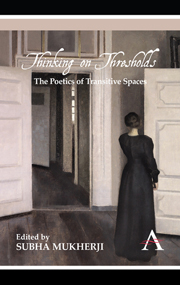Book contents
- Frontmatter
- ACKNOWLEDGEMENTS
- Contents
- List of Illustrations
- Notes on Contributors
- Introduction
- Part One Doors, Windows, Entries
- Part Two Lives and Narratives, Territories and Worlds
- Part Three Matter, Mind, Psyche
- Part Four Reading, Writing, Playing, Listening
- 11 Reading on the Threshold
- 12 When I Begin I have Already Begun
- 13 Thresholds in Improvisation: Freedom, the Eternal Present, and the Death of Jazz
- 14 Thresholds of Attention: On Listening in Literature
- Select Bibliography (including Discography)
11 - Reading on the Threshold
from Part Four - Reading, Writing, Playing, Listening
Published online by Cambridge University Press: 05 March 2012
- Frontmatter
- ACKNOWLEDGEMENTS
- Contents
- List of Illustrations
- Notes on Contributors
- Introduction
- Part One Doors, Windows, Entries
- Part Two Lives and Narratives, Territories and Worlds
- Part Three Matter, Mind, Psyche
- Part Four Reading, Writing, Playing, Listening
- 11 Reading on the Threshold
- 12 When I Begin I have Already Begun
- 13 Thresholds in Improvisation: Freedom, the Eternal Present, and the Death of Jazz
- 14 Thresholds of Attention: On Listening in Literature
- Select Bibliography (including Discography)
Summary
At some point in the mid-1990s, I bought a copy of Shakespeare's Sonnets in a second-hand bookshop in Cambridge. It was the long-outdated edition of W. G. Ingram and Theodore Redpath, published in 1964 by the University of London Press, in the second impression of 1967. It must have sat in the publisher's warehouse for some time before it sold, since a sticker on the dustjacket flap replaces the original price (35 shillings) with a new, decimalised and inflated figure (£3.45). My interest in the book begins, however, with the flyleaf, inscribed in blue biro, in a somewhat shaky hand:
To Ev,
with love,
From Robert.
13th March, 1977.
Lower down on the page, a little black-and-white photograph of the couple has been pasted in, subscribed: ‘Us at Rhodes, / 1933.’
Many such gifts go unread, but this one did not. On the inside cover of the book, this time in Ev's hand, is a list of numbers – reading down, 116, 29, 91, 30, 53, 71, 25, 17. The list refers, of course, to individual sonnets, and it comes as no surprise that 116 (‘Let me not to the marriage of true minds’) should be in the vanguard – if Rhodes was perhaps the venue for a honeymoon, here is the poem of choice for weddings. The sonnet itself goes unmarked, but later items on the list receive explicit annotation. So 29 (‘When in disgrace with Fortune and men's eyes’), which proclaims the transformative effects of ‘thy sweet love rememb'red’, prompts Ev to add: ‘last two lines quite true of R. J. R. to me’.
- Type
- Chapter
- Information
- Thinking on ThresholdsThe Poetics of Transitive Spaces, pp. 157 - 172Publisher: Anthem PressPrint publication year: 2011



